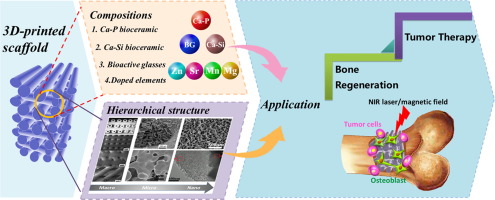Acta Biomaterialia ( IF 9.7 ) Pub Date : 2018-08-28 , DOI: 10.1016/j.actbio.2018.08.026 Hongshi Ma , Chun Feng , Jiang Chang , Chengtie Wu

|
Toward the aim of personalized treatment, three-dimensional (3D) printing technology has been widely used in bone tissue engineering owing to its advantage of a fast, precise, and controllable fabrication process. Conventional bioceramic scaffolds are mainly used for bone tissue engineering; however, there has been a significant change in the application of bioceramic scaffolds during the past several years. Therefore, this review focuses on 3D-printed bioceramic scaffolds with different compositions and hierarchical structures (macro, micro, and nano scales), and their effects on the mechanical, degradation, permeability, and biological properties. Further, this review highlights 3D-printed bioceramic scaffolds for applications extending from bone tissue regeneration to bone tumor therapy. This review emphasizes recent developments in functional 3D-printed bioceramic scaffolds with the ability to be used for both tumor therapy and bone tissue regeneration. Considering the challenges in bone tumor therapy, these functional bioceramic scaffolds have a great potential in repairing bone defects induced by surgery and kill the possibly residual tumor cells to achieve bone tumor therapy. Finally, a brief perspective regarding future directions in this field was also provided. The review not only gives a summary of the research developments in bioceramic science but also offers a new therapy strategy by extending multifunctions of traditional biomaterials toward a specific disease.
Statement of significance
This review outlines the development tendency of 3D-printed bioceramic scaffolds for applications ranging from bone tissue regeneration to bone tumor therapy. Conventional bioceramic scaffolds are mainly used for bone tissue engineering; however, there has been a significant change in the application of bioceramic scaffolds during the past several years. Therefore, this review focuses on 3D-printed bioceramic scaffolds with different compositions and hierarchical structures (macro, micro, and nano scales), and their effects on the mechanical, degradation, permeability, and biological properties. Further, this review highlights 3D-printed bioceramic scaffolds for applications extending from bone tissue regeneration to bone tumor therapy. This review emphasizes recent developments in the functional 3D-printed bioceramic scaffolds with the ability to be used for both bone tumor therapy and bone tissue regeneration.
中文翻译:

3D打印的生物陶瓷支架:从骨组织工程到肿瘤治疗
为了实现个性化治疗的目的,三维(3D)打印技术由于其快速,精确和可控制的制造过程的优势而被广泛用于骨组织工程。常规的生物陶瓷支架主要用于骨组织工程。然而,在过去的几年中,生物陶瓷支架的应用发生了重大变化。因此,本综述着重于具有不同组成和层次结构(宏观,微观和纳米尺度)的3D打印生物陶瓷支架及其对机械,降解,渗透性和生物学特性的影响。此外,本综述重点介绍了从骨骼组织再生到骨骼肿瘤治疗的3D打印生物陶瓷支架。这篇评论强调了功能性3D打印生物陶瓷支架的最新发展,该支架具有用于肿瘤治疗和骨组织再生的能力。考虑到骨肿瘤治疗中的挑战,这些功能性生物陶瓷支架在修复手术引起的骨缺损方面具有巨大潜力,并杀死可能残留的肿瘤细胞以实现骨肿瘤治疗。最后,还简要介绍了该领域的未来发展方向。该综述不仅概述了生物陶瓷科学的研究进展,而且还通过将传统生物材料的多功能性扩展至特定疾病,提供了一种新的治疗策略。这些功能性生物陶瓷支架在修复手术引起的骨缺损方面具有巨大潜力,并杀死可能残留的肿瘤细胞以实现骨肿瘤治疗。最后,还简要介绍了该领域的未来发展方向。该综述不仅概述了生物陶瓷科学的研究进展,而且还通过将传统生物材料的多功能性扩展至特定疾病,提供了一种新的治疗策略。这些功能性生物陶瓷支架在修复手术引起的骨缺损方面具有巨大潜力,并杀死可能残留的肿瘤细胞以实现骨肿瘤治疗。最后,还简要介绍了该领域的未来发展方向。该综述不仅概述了生物陶瓷科学的研究进展,而且还通过将传统生物材料的多功能性扩展至特定疾病,提供了一种新的治疗策略。
重要声明
这篇综述概述了3D打印生物陶瓷支架在从骨组织再生到骨肿瘤治疗等应用中的发展趋势。常规的生物陶瓷支架主要用于骨组织工程。然而,在过去的几年中,生物陶瓷支架的应用发生了重大变化。因此,本综述着重于具有不同组成和层次结构(宏观,微观和纳米尺度)的3D打印生物陶瓷支架及其对机械,降解,渗透性和生物学特性的影响。此外,本综述重点介绍了从骨骼组织再生到骨骼肿瘤治疗的3D打印生物陶瓷支架。


























 京公网安备 11010802027423号
京公网安备 11010802027423号